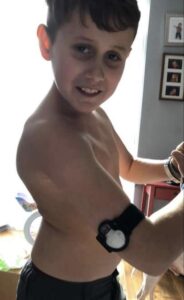A Merseyside mother has warned parents to be on the look-out for signs of potentially fatal T1 diabetes in their children.
Kelly Miller said that although type 1 diabetes is manageable, missing the warning signs could prove life-threatening.
Kelly’s son Harry, 16, was diagnosed with the condition in 2015 when he was just seven. He says that living day to day can be as normal as possible if you maintain type 1 diabetes.

He said: “There isn’t any difference from you and me in life other than testing my blood sugars before I eat a meal, and inserting a cannula [a small tube] every three days.”
Kelly believes that looking after the condition can be a struggle from time to time.
She says: “If you don’t know the signs of T1 diabetes it could result in death. The struggles are the highs and lows of each and every day.
“You don’t know what the day is going to be like, especially with teenage hormones. Stress, school work or just play can have an impact on your levels.”
Yesterday was World Diabetes Day. It is a condition that affects almost 4.1m people in the UK today, with around 10% of those having Type 1 diabetes.
Type 1 diabetes occurs when your pancreas doesn’t make insulin or makes very little. It is generally diagnosed in childhood with very little understanding as to why people get the condition.
Being diagnosed early is so important for all types of diabetes It can save lives, prevent medical emergency and reduce the risk of life-changing complications later.
Knowing the symptoms of diabetes is vital for an early diagnosis. The best way to figure out if someone has type 1 diabetes is by using the 4T’s:
Thinner Tired Thirsty Toilet
Many diabetics use a Continuous Glucose Monitor (CGM) to control their blood sugar levels day to day. These devices connect to your phone via an app to check what level your blood sugar is at.
This decreases the amount of times a diabetic has to test their blood sugar manually by pricking their finger and inserting the blood onto a test strip, connected to a blood glucose monitor.

The most traditional way to give yourself insulin is by injecting it with an insulin pen. However many type 1 diabetics are now using pumps.
They involve using a cannula which is inserted into your stomach and is attached to a small device which allows the insulin to go into your blood stream through the cannula.
Although the condition is manageable and it is possible to live a ‘normal’ life, there are struggles type 1 diabetes face each day when trying to maintain their blood sugar levels.
About 90% of diabetes have Type 2. With this type of diabetes, your body still breaks down carbohydrates from what you consume and turns it into glucose.
The pancreas responds to this by releasing insulin, but because this insulin can’t work properly, your blood sugar levels keep increasing. This means more insulin will be released.
With type 2, managing your blood sugar levels involves frequent exercise and a healthy diet. However some people may need medication to control it or even weight loss surgery for more serious cases.
Some symptoms of type 2 can include the 4T’s as mentioned above, blurred vision, and cuts and wounds taking longer to heal.
Both types of diabetes can be managed efficiently in order to lead healthy life, but knowing the symptoms of each can be vital to early diagnosis.
For more information visit the Diabetes UK website here.
Featured image – Diabetes (c) Volodymyr Bushmelov











